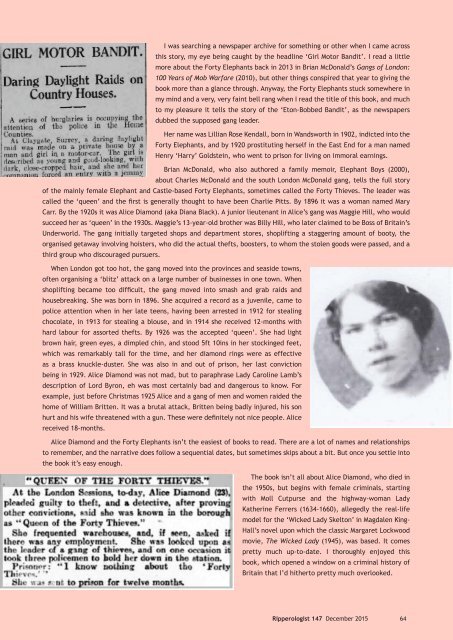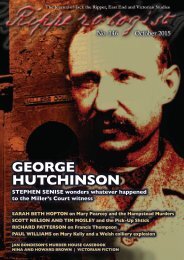Edmund Reid
nuhf574
nuhf574
You also want an ePaper? Increase the reach of your titles
YUMPU automatically turns print PDFs into web optimized ePapers that Google loves.
I was searching a newspaper archive for something or other when I came across<br />
this story, my eye being caught by the headline ‘Girl Motor Bandit’. I read a little<br />
more about the Forty Elephants back in 2013 in Brian McDonald’s Gangs of London:<br />
100 Years of Mob Warfare (2010), but other things conspired that year to giving the<br />
book more than a glance through. Anyway, the Forty Elephants stuck somewhere in<br />
my mind and a very, very faint bell rang when I read the title of this book, and much<br />
to my pleasure it tells the story of the ‘Eton-Bobbed Bandit’, as the newspapers<br />
dubbed the supposed gang leader.<br />
Her name was Lillian Rose Kendall, born in Wandsworth in 1902, indicted into the<br />
Forty Elephants, and by 1920 prostituting herself in the East End for a man named<br />
Henry ‘Harry’ Goldstein, who went to prison for living on immoral earnings.<br />
Brian McDonald, who also authored a family memoir, Elephant Boys (2000),<br />
about Charles McDonald and the south London McDonald gang, tells the full story<br />
of the mainly female Elephant and Castle-based Forty Elephants, sometimes called the Forty Thieves. The leader was<br />
called the ‘queen’ and the first is generally thought to have been Charlie Pitts. By 1896 it was a woman named Mary<br />
Carr. By the 1920s it was Alice Diamond (aka Diana Black). A junior lieutenant in Alice’s gang was Maggie Hill, who would<br />
succeed her as ‘queen’ in the 1930s. Maggie’s 13-year-old brother was Billy Hill, who later claimed to be Boss of Britain’s<br />
Underworld. The gang initially targeted shops and department stores, shoplifting a staggering amount of booty, the<br />
organised getaway involving hoisters, who did the actual thefts, boosters, to whom the stolen goods were passed, and a<br />
third group who discouraged pursuers.<br />
When London got too hot, the gang moved into the provinces and seaside towns,<br />
often organising a ‘blitz’ attack on a large number of businesses in one town. When<br />
shoplifting became too difficult, the gang moved into smash and grab raids and<br />
housebreaking. She was born in 1896. She acquired a record as a juvenile, came to<br />
police attention when in her late teens, having been arrested in 1912 for stealing<br />
chocolate, in 1913 for stealing a blouse, and in 1914 she received 12-months with<br />
hard labour for assorted thefts. By 1926 was the accepted ‘queen’. She had light<br />
brown hair, green eyes, a dimpled chin, and stood 5ft 10ins in her stockinged feet,<br />
which was remarkably tall for the time, and her diamond rings were as effective<br />
as a brass knuckle-duster. She was also in and out of prison, her last conviction<br />
being in 1929. Alice Diamond was not mad, but to paraphrase Lady Caroline Lamb’s<br />
description of Lord Byron, eh was most certainly bad and dangerous to know. For<br />
example, just before Christmas 1925 Alice and a gang of men and women raided the<br />
home of William Britten. It was a brutal attack, Britten being badly injured, his son<br />
hurt and his wife threatened with a gun. These were definitely not nice people. Alice<br />
received 18-months.<br />
Alice Diamond and the Forty Elephants isn’t the easiest of books to read. There are a lot of names and relationships<br />
to remember, and the narrative does follow a sequential dates, but sometimes skips about a bit. But once you settle into<br />
the book it’s easy enough.<br />
The book isn’t all about Alice Diamond, who died in<br />
the 1950s, but begins with female criminals, starting<br />
with Moll Cutpurse and the highway-woman Lady<br />
Katherine Ferrers (1634-1660), allegedly the real-life<br />
model for the ‘Wicked Lady Skelton’ in Magdalen King-<br />
Hall’s novel upon which the classic Margaret Lockwood<br />
movie, The Wicked Lady (1945), was based. It comes<br />
pretty much up-to-date. I thoroughly enjoyed this<br />
book, which opened a window on a criminal history of<br />
Britain that I’d hitherto pretty much overlooked.<br />
Ripperologist 147 December 2015 64




